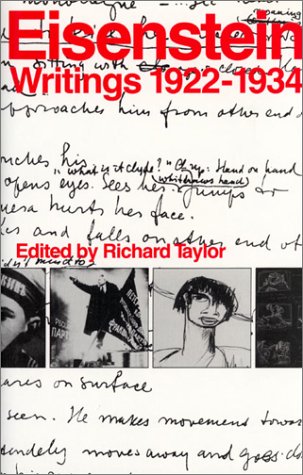Sergei Eisenstein: Selected Works, 1: Writings, 1922-34 (1988)
Filed under book | Tags: · 1920s, 1930s, aesthetics, cinema, film, film theory, ideology, soviet union

This volume is a collection of writings by Sergei Eisenstein, considered by some to be cinema’s most important theorist and author of aesthetic writings in the 20th century. Some of the writings are of his early silent masterpieces, The Strike and The Battleship Potemkin.
Edited and translated by Richard Taylor
Publisher British Film Institute, London, 1988
ISBN 0851702066, 9780851702063
343 pages
PDF (no OCR; updated on 2012-7-14)
Comment (0)Wim Wenders: The Logic of Images: Essays and Conversations (1988/1992)
Filed under book | Tags: · cinema, film, film theory

This book is the companion volume to “Emotion Pictures”. In the book Wenders moves from a contemplation of pure cinema, to a consideration and analysis of his own films. Beginning with the question: Why do you make films?, Wenders expresses his own unique approach to cinema. He then proceeds to discuss the full range of his work, from “Summer in the City” and his early German films, through to “Paris, Texas” and “Wings of Desire”.
Translated by Michael Hofmann
First published in German in 1988 by Verlag der Autoren, Frankfurt, West Germany
Publisher Faber and Faber, London, 1992
ISBN 0571165176, 9780571165179
113 pages
PDF (updated on 2012-7-14)
Comment (1)Michel Chion: The Voice in Cinema (1984–) [EN, ES]
Filed under book | Tags: · cinema, film, film history, film sound, film theory, sound recording, voice

“How can a voice whose source is never seen—such as Hal in 2001: A Space Odyssey or the mother of Norman Bates in Psycho—have such a powerful hold on an audience? When does “synchronized sound” fail to link bodies to their voices, and how do such great stylists of sound film as Jacques Tati, Kenji Mizoguchi, and Marguerite Duras deploy the power of the voice?
In this brilliant essay, Michel Chion, internationally cited authority on the history and poetics of film sound, examines the human voice in cinema. The Voice in Cinema begins with the phenomenon of film’s hidden, faceless voices and their magical powers, particularly in the context of Lang’s Testament of Dr. Mabuse. Chion then explores subjective voices, bonding and entrapment by telephone, voice-thieves, screams (male and female), siren calls, and the silence of mute characters-all uniquely cinematic deployments. In conclusion, Chion considers “the monstrous marriage of the filmed voice and body” as embodied in Norman Bates. Claudia Gorbman’s fluent translation retains Chion’s sophisticated and accessible style, introducing readers to a distinct and paradigm-changing voice on film.”
First published as La voix au cinéma, Cahiers du Cinema, Paris, 1984.
English edition
Edited and translated by Claudia Gorbman
Publisher Columbia University Press, 1999
ISBN 0231108222, 9780231108225
183 pages
Review: Tim Anderson (Echo, 2000).
Publisher (EN)
The Voice in Cinema (English, trans. Claudia Gorbman, 1999, updated on 2020-9-19)
La voz en el cine (Spanish, trans. Maribel Villarino Rodriguez, 2004, added on 2020-9-19)

